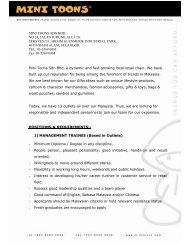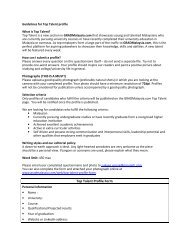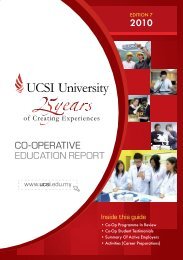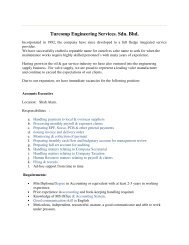MP491/6-Undergraduate Research Project Proposal 1. Title ... - UCSI
MP491/6-Undergraduate Research Project Proposal 1. Title ... - UCSI
MP491/6-Undergraduate Research Project Proposal 1. Title ... - UCSI
Create successful ePaper yourself
Turn your PDF publications into a flip-book with our unique Google optimized e-Paper software.
<strong>MP491</strong>/6-<strong>Undergraduate</strong> <strong>Research</strong> <strong>Project</strong> <strong>Proposal</strong><br />
<strong>1.</strong> <strong>Title</strong>: HPLC method development for analysis of Limonia acidissima bark extract<br />
Supervisor(s)<br />
Main: Dr. Thet Thet Htar<br />
Co- : Dr. Gabriel Akowuah<br />
Objective(s)<br />
<strong>1.</strong> Quantification of bioactive compounds of Limonia acidissima bark extract using HPLC<br />
Abstract<br />
Limonia acidissima (Rutaceae) is commonly known as wood apple (locally<br />
named belinggai), is distributed in dry warm regions of Burma, India, Malaya and Sri<br />
Lanka. Traditionally, the constituents (in paste form) from the stem bark of Limonia<br />
acidissima is mixed with water and applied mainly to the face. 2 It may be used to remove<br />
small spots or lesions which appear on the skin. it is believed that the regular application<br />
on the skin helps to keep skin cool, smooth, fair and well-textured complexion. 3 It is also<br />
known to be protecting against skin cancer by blocking UV rays.<br />
Limonia acidissima is well-known for its medicinal properties. Oil and constituents<br />
derived from the leave, bark, roots and fruit pulp are used as topical application on<br />
venomous wounds and against snakebite. It has been reported that the leaves and fruit<br />
of Limonia acidissima contain fungicides and bactericides and it is insecticidal at high<br />
concentration.<br />
The plant has been reported to contain limonoids in stem bark and root bark,<br />
alkaloids, benzoquinone, flavonoids, triterpenoids in root bark, stem bark, leaves and<br />
fruits. Coumarins isolated from different parts of the plant exhibited antifungal and<br />
insecticidal activities.<br />
As constituents from the stem bark of this plant have been used as a skin<br />
conditioner in traditional cosmetic, we are interested to find out the value of anti-oxidant<br />
activity. Pharmacological activity of botanical products depends on the absorption of<br />
specific active constituents through the skin. Therefore, the chemical identification and<br />
quantification of the active constituents which are responsible for the pharmacological<br />
activities of the bark of Limonia acidissima will be useful in illustrating their mechanism<br />
and promoting their commercial development.<br />
1
2. <strong>Title</strong>: Antimicrobial Susceptibility Testing of Murraya koenigii extract on<br />
Staphylococcus aureus<br />
Supervisor(s)<br />
Main: Ms Priya<br />
Co- : Dr. Thet Thet Htar<br />
Objective(s)<br />
<strong>1.</strong> To determine the minimal inhibitory concentration value using disk diffusion method<br />
and microdilution assay on Staphylococcus aureus cultures.<br />
Abstract<br />
Natural products have shown that they are potential source of antimicrobial<br />
agents, such as neem leaves and curry leaves. Since antimicrobial therapy is going<br />
through a crisis with the increasing resistance towards antimicrobial agents, it is<br />
important to screen new plants and study their effectiveness in their antimicrobial<br />
activities.<br />
Staphylococcus aureus, gram positive bacteria that typically occur in grape-like<br />
clusters have yellow pigmented colonies. They seem to be the most pathogenic of all the<br />
staphylococci and are often a problem in the hospital environment. Infections by<br />
staphylococci have become difficult to treat as they have become resistant to many<br />
antibiotics that are exposed in the hospital environment. Folliculitis, food poisoning, toxic<br />
shock syndrome, impetigo are some of the diseases caused by S. aureus strains.<br />
3. <strong>Title</strong>: Sub-chronic (28 days) toxicity study of Limonia acidissima bark extract in rats.<br />
Supervisor(s)<br />
Main: Dr. Chin Jin Han<br />
Co-: Dr. Gabriel Akowuah<br />
Objective(s)<br />
<strong>1.</strong> To examine the possible toxic or adverse effect of L. acidissima bark extract in rats.<br />
2. To determine LD 50 of Limonia acidissima extract.<br />
Abstract<br />
Limonia acidissima (Rutaceae) is commonly known as wood apple (locally<br />
named belinggai), is distributed in dry warm regions of Burma, India, Malaya and Sri<br />
Lanka. Oil and constituents derived from the leave, bark, roots and fruit pulp are used as<br />
topical application on venomous wounds and against snakebite. An interesting feature of<br />
the plants classified within the family Rutaceae is that they contain several types of<br />
cytotoxic, antimicrobial, neuroactive quinoleic alkaloids derived from anthranilic acid. The<br />
plant has been reported to contain limonoids in stem bark and root bark, alkaloids,<br />
benzoquinone, flavonoids, triterpenoids in root bark, stem bark, leaves and fruits.<br />
However, toxicity studies on this plant have not been reported extensively. Therefore,<br />
this study aims to ensure the safe use of this plant for therapeutic purposes.<br />
2
4. <strong>Title</strong>: Toxicity effects of sub-chronic administration of Limonia acidissima bark extract<br />
on blood parameters of rats.<br />
Supervisor(s)<br />
Main: Prof Noran<br />
Co- : Dr Chin<br />
Objectives<br />
<strong>1.</strong> To measure the haematocrit values of normal and treated rats.<br />
2. To determine RBC and WBC counts.<br />
3. To measure the Hb content of RBC.<br />
4. To prepare blood smears of normal and treated rats using giemsa and Wright<br />
staining methods for morphological evaluation.<br />
Abstract<br />
The cellular components of blood are essential for carrying out its vital functions. The<br />
erythrocytes (RBC) are primarily involved in oxygen and carbon dioxide transport, the<br />
leucocytes (WBC) constitute an important part of the defence and immune systems of<br />
the body, and thrombocytes (platelets) are vital for blood clotting. Any changes in these<br />
blood components due to infections or exposure to chemicals will ultimately affect<br />
normal physiological functions, hence monitoring these parameters is one of the<br />
approaches in determining the effects of exposure to Limonia acidissima bark extract.<br />
5. <strong>Title</strong>: Toxicity effects of sub-chronic administration of Limonia acidissima bark extract<br />
on sperm quality of rats.<br />
Supervisor(s)<br />
Main: Prof Noran<br />
Co- : Dr Chin<br />
Objective(s)<br />
<strong>1.</strong>Extraction of seminal fluid from isolated rat epididymis for determination of mortality<br />
rate, sperm counts and percentage of progressive forward movements.<br />
2.Preparation of sperm smears for morphological analyses.<br />
Abstract<br />
Sub-chronic or chronic exposure to various chemicals or drugs may affect sperm<br />
production and morphology in males. Although application of extract from the plant<br />
Limonia acidissima has been reported to have many beneficial effects but there has<br />
been no report on the effects of exposure to sub-chronic doses of its bark extract on<br />
fertility. One of the first sign would be damages to sperm production, hence the fist step<br />
would be to look at semen quality by studying sperm viability.<br />
3
6. <strong>Title</strong>: Evaluation of hypoglycemic activity of Limonia acidissima bark extract.<br />
Supervisor(s)<br />
Main: Mr. Nalamolu Koteswara Rao.<br />
Co- : Dr. Gabriel Akowuah.<br />
Objective(s)<br />
<strong>1.</strong> Evaluation of hypoglycemic activity of Limonia acidissima bark extract using<br />
streptozotocin-induced diabetic rats.<br />
Abstract<br />
Diabetes mellitus is an endocrine disorder that is characterized by hyperglycemia and<br />
a number of complications such as nephropathy, retinopathy, neuropathy, and<br />
cardiopathy. A worldwide survey showed that nearly 10% of the population is affected by<br />
this disorder. Modern treatment of diabetes based on oral hypoglycaemics<br />
(sulphonylureas, biguanides and –glucosidase inhibitors) and insulin showed an<br />
adverse effect with relatively high rates of secondary failure. As an alternative approach,<br />
scientific investigation on traditional remedies has led to the discovery of herbal drugs for<br />
the treatment of diabetes mellitus. An estimated 90% of the population in rural areas of<br />
developing countries still relies on traditional medicines for their primary health care.<br />
Limonia acidissima (Rutaceae), commonly known as wood apple (locally named<br />
belinggai), is distributed in dry warm regions of Burma, India, Malaya and Sri Lanka.<br />
Traditionally, the constituents (in paste form) from the bark of L. acidissima is mixed with<br />
water and applied mainly to the face for removal of small spots or lesions for a smooth,<br />
fair and well-textured complexion. It is also known to protect against skin cancer by<br />
blocking UV rays. Oil and constituents derived from the leaf, bark, root and fruit pulp are<br />
used against snake bites, and as fungicides, bactericides and insecticides.<br />
As constituents of bark extract from this plant have been used in traditional medicine<br />
for diabetes management, we are interested to find out the value of its hypoglycemic<br />
activity. Therefore, the evaluation of hypoglycemic activity of bark extract of L.<br />
acidissima will be useful in illustrating its mechanism of action and promote its<br />
commercial development.<br />
7. <strong>Title</strong>: Patient-Focused Medication Adherence Type-II Diabetes Mellitus<br />
Supervisor(s)<br />
Main: Assoc. Prof. Dr. Yeong Siew Wei<br />
Co- : None<br />
Objectives:<br />
<strong>1.</strong> To evaluate the effectiveness of a patient-focused tool in improving medication adherence<br />
among Type-II diabetic patients.<br />
2. To develop a patient Medication Adherence Plan (MAP) for improving medication adherence in<br />
diabetes mellitus.<br />
4
Abstract<br />
Definition of the expected results:<br />
<br />
<br />
The effectiveness of the patient-focused tool will be evaluated by analysing data with<br />
various statistical tools. A significant level will be set at < 0.05.<br />
The patient-focused tool from the project will be refined and to be suggested to the<br />
relevant authority as a practical tool for improving medication adherence in the practical<br />
settings.<br />
Patients and practitioners<br />
Knowledge of effective communication from this project will translate into better patientpractitioner’s<br />
communication. This will help in enhancing the therapeutic effectiveness of<br />
therapy.<br />
Patients would be able to identify and recognize their roles in taking charge of their own<br />
health.<br />
Practitioners would gain important skills and tools in effectively communicating to their<br />
patients on medication adherence.<br />
8. <strong>Title</strong>: Development of improved (high performance thin layer chromatography)<br />
HPTLC method for estimation of levofloxacin in dosage forms.<br />
Supervisor(s)<br />
Main: A. Mohamed Saleem.<br />
Co- : None.<br />
Fig. <strong>1.</strong> Levofloxacin [(-)-(S)-9-fluoro-2,3-dihydro-3-methyl-10-(4-methyl-1-piperazinyl)-7-<br />
oxo-7H-pyrido[1,2,3-de]-1,4-benzoxazine-6-carboxylic acid]<br />
CAS Registry Number: 100986-85-4<br />
Chemical Formula: C 18 H 20 FN 3 O 4<br />
Molecular Weight: 36<strong>1.</strong>37<br />
Abstract<br />
During the last two decades, quinolones have become an increasingly important<br />
and expanding family of antibacterial agents. The quinolone, levofloxacin (Fig. 1) have<br />
activity against both Gram(+) and Gram(–) bacteria (aerobic and anaerobic) through<br />
inhibition of the bacterial enzyme (DNA gyrase) that maintains the super-twisted helical<br />
structure of DNA. Levofloxacin is administered to patients with urinary, respiratory or<br />
cutaneous infections in 500 mg day –1 dose.<br />
5
Due to the overlap of their absorption and emission spectra and matrix effects<br />
found when working with chemical/biological samples (emission or absorption of the<br />
matrix components, attenuation of analyte signals, etc.), the determination of<br />
levofloxacin, by means of spectrophotometric or spectrofluorometric methods,<br />
traditionally requires a prior separation stage. This step is usually performed by HPLC<br />
techniques.<br />
Considering the rapid nature and economical advantages of HPTLC method of<br />
analysis when compared to HPLC method of analysis, development of HPTLC method<br />
for analysis of levofloxacin in different dosage forms is proposed through this project<br />
proposal.<br />
Also, the literature review indicated that only one HPTLC method has been<br />
reported so far for the analysis of levofloxacin. However, the detailed introspection of the<br />
reported method revealed that lamotrigine was used as an internal standard. It is<br />
proposed to use levofloxacin as an internal standard in our method. Also the mobile<br />
phase used was water-methanol-n-butanol-ammonia solution. In our previous personal<br />
study, it was found that this mobile phase took long time to ascend the TLC plate<br />
resulting in unusually longer duration of analysis. So, it is proposed to use a better<br />
mobile phase in our method to shorten the analysis time.<br />
The methodology to be used for development of HPTLC analysis method in this<br />
project is described as follows. A suitable solvent would be identified for dissolving the<br />
different dosage forms so as to get maximum amount of levofloxacin in solution (this<br />
would again be confirmed with recovery study also). Then a suitable mobile phase would<br />
be selected based on the chemistry of levofloxacin and trial and error method. Then the<br />
UV densitometric analysis by absorbance mode would be carried out to estimate the<br />
amount of levofloxacin in different dosage forms.<br />
The objective of this study is to develop an improved HPTLC method which can<br />
be used for routine analysis of levofloxacin dosage forms in a pharmaceutical quality<br />
control laboratory.<br />
9. <strong>Title</strong>: Determination of Heavy Metals in Herbal Supplements in Malaysia Market<br />
Supervisor(s)<br />
Main: Ms. Wong Pooi See<br />
Co- : Dr. Gabriel Akowuah<br />
Objective(s)<br />
<strong>1.</strong> To identify type of heavy metals in herbal supplements in Malaysia market<br />
2. To determine the concentration/level of heavy metals in herbal supplements in<br />
Malaysia market.<br />
Abstract<br />
Herbal supplements become more popular in Malaysia for the past 20 years. The Drug<br />
Control Authority (DCA) in Malaysia have recognized the increasing use of herbal<br />
medicines and implemented the phase 3 registration of traditional medicines. The<br />
registration criteria for any traditional medicine in Malaysia include limits for heavy<br />
metals such as lead, mercury, arsenic and cadmium. Most of the supplements are sold<br />
as OTC products in the local market. Some of the products might not have gone through<br />
6
the appropriate registration procedure. High level of heavy metals in supplements will<br />
lead to severe adverse effects to the human body such as kidney failure and<br />
neurological damage. Four metals (Cd, Pd, Hg and As) will be determined from the<br />
herbal supplement products by using Atomic atomic absorption spectroscopy (AAS) and<br />
inductively coupled plasma-atomic emission spectrometry (ICP-AES). The obtained<br />
result will be assessed in compliance with the WHO Standard.<br />
10. <strong>Title</strong>: Estimation of antioxidant activity of lawsone by using potentiometer<br />
Supervisor(s)<br />
Main: Mr.Bontha V S Lokesh<br />
Co- : None<br />
Objective(s)<br />
<strong>1.</strong> To design a methodology for estimation of the antioxidant activity of pure lawsone and<br />
its content in henna leaves electrochemically<br />
2. Comparison of the antioxidant effect of lawsone with powerful antioxidant vitamins like<br />
Vitamin C and E<br />
3. Estimation of purity of commercial herbal henna products in Malaysia.<br />
Abstract<br />
Lawsonia inermis (henna) contains a red-orange pigment, (lawsone), which is<br />
also known as hennotannic acid. When henna leaves are crushed in an acidic medium<br />
and applied to skin, the lawsone molecules migrate from the henna paste, traverse the<br />
outermost skin layer stratum corneum and stain the layer. It is powerful antioxidant.<br />
Lawsone is chemically known as 2-hydroxy-1,4-naphthoquinone and is also<br />
described as Natural Orange 6 industrially. The name and molecular structure of<br />
lawsone show its congeniality to naphthalene 2 . In lawsone, two oxygen atoms are<br />
attached to the naphthalene carbons at positions 1 and 4 to form 1,4-naphoquinone and<br />
a hydroxyl (–OH) group is present at position 2. Its molecule formula is given to be<br />
C 10 H 6 O 3 and its total molecular weight of 174.16. Pure lawsone is an orange powder,<br />
7
insoluble in water, with a melting point higher than 192ºC and optical absorption<br />
maximum of 452 nm.<br />
In the proposed project, few experiments may be conducted to estimate the<br />
antioxidant activity of lawsone and comparison studies may also be studied with natural<br />
antioxidant vitamins like Vitamin C and E. The developed electrochemical methods may<br />
be further extended to determine the antioxidant activity and purity of lawsone in henna<br />
leaves and on selected henna herbal products. To make use of current electrochemical<br />
analytical techniques like potentiometry, the antioxidant activity may be determined<br />
precisely with reference compounds.<br />
1<strong>1.</strong> <strong>Title</strong>: Design and synthesis of stilbene derivative(s) with potential anti-cancer activity<br />
Supervisor(s)<br />
Main: Dr. Thet Thet Htar<br />
Co- : Dr. Gabriel Akowuah<br />
Prof. Dr. Jean-Frèdèric Faizal Weber Abdullah (UiTM)<br />
Objective(s)<br />
<strong>1.</strong> To design and synthesize stilbene derivative(s) with potential anti-cancer activity<br />
Abstract<br />
It has been great interest in the study of stilbene derivatives for their biological<br />
activities such as antileukemic, anti-cancer activity i . Stilbene itself is not a natural<br />
product although naturally occurring stilbenoid compounds such as<br />
polyhydroxystilbenes and their glucosides have been is present in grape vine, Southeast<br />
Asian Timber trees. For instance, naturally hydroxylated stilbene, resveratrol<br />
(figure 1) is well known for heart protecting activity, platelet antiaggregating<br />
capability, herpes simplex viruses inhibition, cancer chemopreventive activity and<br />
anti-oxidative activity ii .<br />
HO<br />
OH<br />
OH<br />
Figure <strong>1.</strong> Resveratrol<br />
Resveratrol is indeed the biosynthetic precursor of most oligostibenoids (e.g<br />
viniferins) and is classified as phytoalexins. Consequence, resveratrol and its<br />
analogues present minute amounts in plants as it occurs during the stress situation<br />
of the pant. Therefore, other alternative sources of supply on stilbene derivatives<br />
through retrosynthesis have been interested. Furthermore, resveratrol has been<br />
shown to induce apoptosis in different cancer cell lines.<br />
8
Stilbene derivatives (A) and (B) prepared at the institute Kajian Ubat Semulajadi<br />
(iKUS), under Faculty of Pharmacy, UiTM has been found with potent anti-cancer<br />
activity on K562 cell lines. Based on these results, synthesis of more stilbene<br />
derivatives relative to (A) and (B) has been proposed to complete the SAR study.<br />
OH<br />
OAc<br />
(A)<br />
BnO<br />
OBn<br />
Cl<br />
(B)<br />
9
















